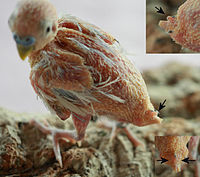
Photo from wikipedia
Abstract Preen gland secretions spread on the feathers contain various chemical compounds dominated by fatty acids (FAs) and volatile organic compounds (VOCs). These chemicals may significantly affect plumage condition, microbial… Click to show full abstract
Abstract Preen gland secretions spread on the feathers contain various chemical compounds dominated by fatty acids (FAs) and volatile organic compounds (VOCs). These chemicals may significantly affect plumage condition, microbial and ectoparasitic load on feathers, and chemical communication of birds. However, how chemical composition of preen secretions varies in commercially produced chickens with respect to their genotype, sex, and feeding regime remain largely unknown, as well as the welfare implications for farmed poultry. We found that while polyunsaturated fatty acids in chicken preen secretions differed significantly with genotype (P << 0.001), saturated fatty acids and monounsaturated fatty acids varied with genotype-dependent preen gland volume (P < 0.01). Chickens of meat-type fast-growing Ross 308 genotype had reduced preen gland volume and lower proportions of all FA categories in their preen secretions compared with dual-purpose slow-growing ISA Dual chickens. A total of 34 FAs and 77 VOCs with tens of unique FAs were detected in preen secretions of both genotypes. While differences in the relative proportion of 6 of the 10 most dominant VOCs in chicken preen gland secretions were related to genotype (P < 0.001), only 1 of the 10 most dominant VOCs showed a sex effect (P < 0.01), and only 2 of the 10 most dominant VOCs showed a genotype-dependent effect of feed restriction (P < 0.05). Feed restriction had no effect on the relative proportion of any of the FAs in chicken preen gland secretions. Moreover, we found that meat-type Ross 308 preen secretions were dominated by VOCs, which are proven attractants for poultry red mite and may also increase infestation with other ectoparasites and negatively influence overall odor-mediated intraspecific communication and welfare. This study shows that no feeding management, but long-term genetic selection in commercial breeding may be the main cause of the differences in the biochemistry and function of chicken preen secretions. This might have negative consequences for chemosignaling, antiparasitic, and antimicrobial potential of preen secretions and can lead to increased susceptibility to ectoparasites, plumage care disorders, and can affect the overall condition, welfare, and productivity of commercially bred chickens. Selection-induced preen gland impairments must therefore be considered and compensated by proper management of the chicken farm and increased care about animal well-being.
Journal Title: Journal of Animal Science
Year Published: 2022
Link to full text (if available)
Share on Social Media: Sign Up to like & get
recommendations!